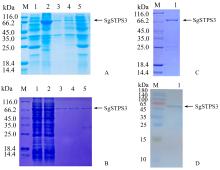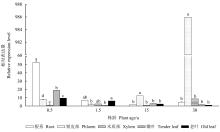

Scientia Silvae Sinicae ›› 2021, Vol. 57 ›› Issue (11): 68-78.doi: 10.11707/j.1001-7488.20211107
Previous Articles Next Articles
Zhaoli Chen1,2,Niu Yu1,Rongsheng Li1,Wentao Zou1,Mingliang Dong1,Maocheng Zhu1,Jinchang Yang1,*
Received:2020-11-11
Online:2021-11-25
Published:2022-01-12
Contact:
Jinchang Yang
CLC Number:
Zhaoli Chen,Niu Yu,Rongsheng Li,Wentao Zou,Mingliang Dong,Maocheng Zhu,Jinchang Yang. Cloning and Expression Analysis of Sesquiterpene Synthase Gene SgSTPS3 in Sindora glabra[J]. Scientia Silvae Sinicae, 2021, 57(11): 68-78.
Table 1
Primers used in the test"
| 名称Primer name | 序列Primer sequence (5′—3′) |
| SgSTPS3 F | ATGGCTACTGAAGTTTCAAAACATG |
| SgSTPS3 R | TCATGGGTTGTTGAATGCGT |
| SgSTPS3-BamHⅠ | CGCGTCGACATGGCTACTGAAGTTTCAAAAC |
| SgSTPS3-XhoⅠ | CCGCTCGAGTCATGGGTTGTTGAATGC |
| qSgSTPS3 F | CCGTTGCCCTACTCTTTCGT |
| qSgSTPS3 R | ATGTTCCACTTGTGCCCCAA |
| Actin-2 F | CATGAAGTGTGATGTGGATA |
| Actin-2 R | CCTTGCTCATTCTATCAGCA |

Fig.4
Protein expression, purification and Western Blot analysis diagram A: SDS-PAGE analysis diagram of fusion protein expression test(M: Protein marker; 1: Total protein before induction; 2: 20 ℃ supernatant; 3: 20 ℃ precipitation; 4: 37 ℃ supernatant; 5: 37 ℃ precipitation); B: SDS-PAGE analysis diagram of fusion protein purification(1: Sample loading; 2: Outflow; 3: 20 mmol·L-1 imidazole elution component; 4: 50 mmol·L-1 imidazole elution component; 5: 500 mmol·L-1 imidazole elution component); C: SDS-PAGE analysis diagram of SgSTPS3 purified protein; D: Western Blot analysis diagram of SgSTPS3 purified protein."


Fig.6
Gene expression of SgSTPS 3 in different organs of S. glabra plant at the same age Different lowercase lerrers indicate significant statistical differences (P < 0.05), the same below. Relative gene expression control organs: 0.5 years old for xylem, 1.5 years old for tender leaves, 15 years old for xylem, 30 years old for old leaves."

| 黄全. 海南岛的油楠. 林业科技通讯, 1981, 24 (10): 21. | |
| Huang Q . Sindora glabra of Hainan island. Forest Science and Technology, 1981, 24 (10): 21. | |
| 陆碧瑶, 李毓敬, 麦浪天, 等. 油楠油挥发成分的研究. 林产化学与工业, 1982, 2 (1): 27- 31. | |
| Lu B Y , Li Y J , Mai L T , et al. Study on the volatile constituents of Sindora glabra oil. Chemistry and Industry of Forest Products, 1982, 2 (1): 27- 31. | |
| 王焕. 2015. MeJA影响阳春砂挥发性萜类和转录组变化的研究. 广州: 广州中医药大学硕士学位论文. | |
| Wang H. 2015. Research on volatile terpenoids and transcriptome changes of MeJA-induced Amomum villosum Lour. Guangzhou: MS thesis of Guangzhou University of Chinese Medicine. [in Chinese] | |
| 王凌健, 方欣, 杨长青, 等. 植物萜类次生代谢及其调控. 中国科学: 生命科学, 2013, 43 (12): 1030- 1046. | |
| Wang L J , Fang X , Yang C Q , et al. Biosynthesis and regulation of secondary terpenoid metabolism in plants. Scientia Sinica Vitae, 2013, 43 (12): 1030- 1046. | |
| 吴忠锋, 杨锦昌, 成铁龙, 等. 海南油楠的重要生物学特性及产油特征. 林业科学, 2014, 50 (4): 144- 151. | |
| Wu Z F , Yang J C , Cheng T L , et al. Biological characteristics and oleoresin production of Sindora glabra in Hainan island. Scientia Silvae Sinicae, 2014, 50 (4): 144- 151. | |
|
杨锦昌, 李琼琼, 尹光天, 等. 海南尖峰岭野生油楠不同单株树脂化学成分研究. 林业科学研究, 2016, 29 (2): 245- 249.
doi: 10.3969/j.issn.1001-1498.2016.02.015 |
|
|
Yang J C , Li Q Q , Yin G T , et al. Study on chemical components of oleoresin from different wild Sindora glabra individuals in Jianfengling, Hainan, China. Forest Research, 2016, 29 (2): 245- 249.
doi: 10.3969/j.issn.1001-1498.2016.02.015 |
|
|
Ajikumar P K , Xiao W H , Tyo K E J , et al. Isoprenoid pathway optimization for taxol precursor overproduction in Escherichia coli. Science, 2010, 330 (6000): 70- 74.
doi: 10.1126/science.1191652 |
|
| Ashour M , Wink M , Gershenzon J . Biochemistry of terpenoids: monoterpenes, sesquiterpenes and diterpenes. Annual Plant Reviews, 2018, 40, 258- 303. | |
|
Aubourg S , Lecharny A , Bohlmann J . Genomic analysis of the terpenoid synthase (AtTPS) gene family of Arabidopsis thaliana. Molecular Genetics and Genomics, 2002, 267 (6): 730- 745.
doi: 10.1007/s00438-002-0709-y |
|
|
Booth J K , Yuan M M S , Jancsik S , et al. Terpene synthases and terpene variation in Cannabis sativa. Plant Physiology, 2020, 184 (1): 130- 147.
doi: 10.1104/pp.20.00593 |
|
| Chen F , Al-Ahmad H , Joyce B , et al. Within-plant distribution and emission of sesquiterpenes from Copaifera officinalis. Plant Physiology and Biochemistry, 2009, 47 (11): 1017- 1023. | |
|
Chen F , Tholl D , Bohlmann J , et al. The family of terpene synthases in plants: a mid-size family of genes for specialized metabolism that is highly diversified throughout the kingdom. The Plant Journal, 2011, 66 (1): 212- 229.
doi: 10.1111/j.1365-313X.2011.04520.x |
|
|
Cör D , Knez Ž , Knez Hrnčič M . Antitumour, antimicrobial, antioxidant and antiacetylcholinesterase effect of Ganoderma lucidum terpenoids and polysaccharides: A review. Molecules, 2018, 23 (3): 649- 670.
doi: 10.3390/molecules23030649 |
|
|
Irmisch S , Jiang Y , Chen F , et al. Terpene synthases and their contribution to herbivore-induced volatile emission in western balsam poplar (Populus trichocarpa). BMC Plant Biology, 2014, 14 (1): 1- 16.
doi: 10.1186/1471-2229-14-1 |
|
| Jennewein S , Croteau R . Taxol: biosynthesis, molecular genetics, and biotechnological applications. Applied Microbiology and Biotechnology, 2001, 57 (1): 13- 19. | |
| Joyce B L. 2013. Toward direct biosynthesis of drop-in ready biofuels in plants: rapid screening and functional genomic characterization of plant-derived advanced biofuels and implications for coproduction in lignocellulosic feedstocks. Knoxville: PhD thesis of University of Tennessee. | |
|
Keeling C I , Weisshaar S , Ralph S G , et al. Transcriptome mining, functional characterization, and phylogeny of a large terpene synthase gene family in spruce (Picea spp. ). BMC Plant Biology, 2011, 11 (1): 43- 57.
doi: 10.1186/1471-2229-11-43 |
|
| Majdi M , Abdollahi M R , Maroufi A . Parthenolide accumulation and expression of genes related to parthenolide biosynthesis affected by exogenous application of methyl jasmonate and salicylic acid in Tanacetum parthenium. Plant Cell Reports, 2015, 4 (11): 1909- 1918. | |
|
Martin D M , Gershenzon J , Bohlmann J . Induction of volatile terpene biosynthesis and diurnal emission by methyl jasmonate in foliage of Norway spruce. Plant Physiology, 2003, 132 (3): 1586- 1599.
doi: 10.1104/pp.103.021196 |
|
|
Martin D M , Fäldt J , Bohlmann J . Functional characterization of nine Norway spruce TPS genes and evolution of gymnosperm terpene synthases of the TPS-d subfamily. Plant Physiology, 2004, 135 (4): 1908- 1927.
doi: 10.1104/pp.104.042028 |
|
|
Martin D M , Aubourg S , Schouwey M B , et al. Functional annotation, genome organization and phylogeny of the grapevine (Vitis vinifera) terpene synthase gene family based on genome assembly, FLcDNA cloning, and enzyme assays. BMC Plant Biology, 2010, 10 (1): 226.
doi: 10.1186/1471-2229-10-226 |
|
|
Nagegowda D A , Gutensohn M , Wilkerson C G , et al. Two nearly identical terpene synthases catalyze the formation of nerolidol and linalool in snapdragon flowers. The Plant Journal, 2008, 55 (2): 224- 239.
doi: 10.1111/j.1365-313X.2008.03496.x |
|
|
Ozawa R , Arimura G , Takabayashi J , et al. Involvement of jasmonate and salicylate-related signaling pathways for the production of specific herbivore induced volatiles in plants. Plant and Cell Physiology, 2000, 41 (4): 391- 398.
doi: 10.1093/pcp/41.4.391 |
|
|
Schnee C , Köllner T G , Gershenzon J , et al. The maize gene terpene synthase 1 encodes a sesquiterpene synthase catalyzing the formation of (E)-β-farnesene, (E)-nerolidol, and (E, E)-farnesol after herbivore damage. Plant Physiology, 2002, 130 (4): 2049- 2060.
doi: 10.1104/pp.008326 |
|
|
Shabani L , Ehsanpour A A , Esmaeili A . Assessment of squalene synthase and beta-amyrin synthase gene expression in licorice roots treated with methyl jasmonate and salicylic acid using real-time qPCR. Russian Journal of Plant Physiology, 2010, 57 (4): 480- 484.
doi: 10.1134/S1021443710040047 |
|
|
Tetali S D . Terpenes and isoprenoids: a wealth of compounds for global use. Planta, 2019, 249 (1): 1- 8.
doi: 10.1007/s00425-018-3056-x |
|
|
Türkez H , Togar B , Di Stefano A , et al. Protective effects of cyclosativene on H2O2-induced injury in cultured rat primary cerebral cortex cells. Cytotechnology, 2015, 67 (2): 299- 309.
doi: 10.1007/s10616-013-9685-9 |
|
|
Türkez H , Çelik K , Togar B . Effects of copaene, a tricyclic sesquiterpene, on human lymphocytes cells in vitro. Cytotechnology, 2014, 66 (4): 597- 603.
doi: 10.1007/s10616-013-9611-1 |
|
|
Wei G , Jia Q , Chen X , et al. Terpene biosynthesis in red algae is catalyzed by microbial type but not typical plant terpene synthases. Plant Physiology, 2019, 179 (2): 382- 390.
doi: 10.1104/pp.18.01413 |
|
| Wright C W . Traditional antimalarials and the development of novel antimalarial drugs. Journal of Ethnopharmacology, 2005, 100 (1): 67- 71. | |
| Yahyaa M , Matsuba Y , Brandt W , et al. Identification, functional characterization, and evolution of terpene synthases from a basal dicot. Plant Physiology, 2015, 169 (3): 1683- 1697. | |
| Yang C Q , Wu X M , Ruan J X , et al. Isolation and characterization of terpene synthases in cotton (Gossypium hirsutum). Phytochemistry, 2013, 96 (12): 46- 56. | |
| Yu N , Yang J C , Yin G T , et al. Transcriptome analysis of oleoresin-producing tree Sindora glabra and characterization of sesquiterpene synthases. Frontiers in Plant Science, 2018, 9 (11): 1619- 1636. | |
|
Yu N , Li Q Q , Yang J , et al. Variation in oleoresin yield and anatomical traits among Sindora glabra populations in Hainan, China. Trees, 2020, 34 (5): 1323- 1334.
doi: 10.1007/s00468-020-02000-y |
|
|
Zhou F , Pichersky E . The complete functional characterisation of the terpene synthase family in tomato. New Phytologist, 2020, 226 (5): 1341- 1362.
doi: 10.1111/nph.16431 |
| [1] | Minhao Liu,Long Li,Jing Ye,Xuanyuan Zhou,Zhouqi Li,Ruishen Fan,Junlei Xu. Genome-Wide Identification and Expression Analysis of the ARF Gene Family in Eucommia ulmoides [J]. Scientia Silvae Sinicae, 2021, 57(3): 170-180. |
| [2] | Yaqian Yang,Ying Fu,Mingbing Zhou. Identification of Cytokinin Related Genes and Characterization of Their Expression in Phyllostachys edulis Shoots [J]. Scientia Silvae Sinicae, 2019, 55(12): 61-73. |
| [3] | Ni Fei, Li Wenhao, Lin Erpei, Tong Zaikang, Huang Huahong. Cloning, Expression and Regulation of MYB Genes in Betula luminifera [J]. Scientia Silvae Sinicae, 2018, 54(12): 70-81. |
| [4] | Wang Kaili, Fu Ying, Zhou Mingbing. Identification and Expression Pattern of SQUAMOSA Promoter Binding Protein (SBP) Family Genes in Phyllostachys edulis [J]. Scientia Silvae Sinicae, 2017, 53(12): 50-61. |
| [5] | Xu Meng;Xie Wenfan;Pan Huixin;Su Xiaohua;Zhang Shougong;Huang Minren. Cloning and Characterization of ARGONAUTE Genes in Populus [J]. Scientia Silvae Sinicae, 2011, 47(3): 46-51. |
| [6] | Pei Dong;Yuan Lichai;Gu Ruisheng;Jiang Xiangning. REGULATION OF JUGLANS REGIA COTYLEDON RHIZOGENESIS [J]. Scientia Silvae Sinicae, 2003, 39(6): 33-39. |
| Viewed | ||||||
|
Full text |
|
|||||
|
Abstract |
|
|||||